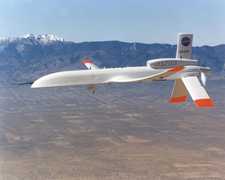The Gerdien Probe is an in situ airborne conductivity device. It measures atmospheric electrical conductivity by recording the time it takes for a sample of air to discharge after being exposed to a capacitor. The Gerdien probe can detect both positive and negative ions. It can be mounted on aircraft, uncrewed aerial systems (UAS), and rockets.

Instrument Details
- Magnetic/Electric
- Earth Science > Atmosphere > Atmospheric Electricity > Atmospheric ConductivityEarth Science > Atmosphere > Atmospheric Electricity
- Troposphere
- N/A
- Point
- N/A
- Currently unavailble
Currently unavailable
Currently unavailable
Penn State
Currently unavailable
Currently unavailable
 ALTUS II 1 Campaign · 8 Instruments |  Altus Cumulus Electrification Study 2002 Florida Everglades 1 Deployment · 6 Data Products
|
Filter data products from this instrument by specific campaigns, platforms, or formats.
CAMPAIGNS
PLATFORMS